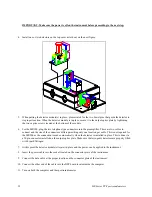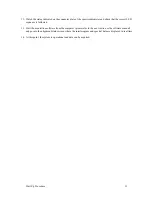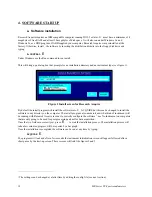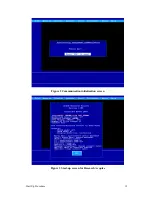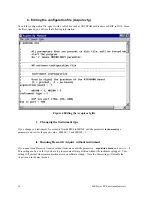
MR Series FT-Spectroradiometers
22
desiccant material is satisfactory (by color.) The frequency of this schedule should be dependent upon the
environment and for cases where the ambient humidity level is unchecked the frequency should be increased.
Typically, the frequency to check the desiccant (and optical materials) should be on a monthly basis. If the
desiccant is not checked periodically, it can become a source of moisture that may damage optical materials.
As a side note, desiccant materials can usually be regenerated by heating the material to rid excess moisture.
This can be accomplished by placing the desiccant in an oven and heated at 100 degrees Celsius for some period
of time until the color comes back to the “dry” state. An alternate method can be to microwave the desiccant. A
power level of 80% for approximately 10 minutes should regenerate the desiccant to its “dry” state, BUT make
sure that the evaporated moisture can escape from the desiccant enclosure. Consult with the supplier of the
desiccant if you are unsure in this respect.
Heating
By heating the optical elements above ambient temperature levels encountered, it can be ensured that the
element remain above the temperature at which condensation may occur onto the surface of the material. [See
Appendix I-4 for discussion of relative humidity.] This can be achieved by raising the temperature locally by
using some appropriate device. If no other means are available, a small heat source such as a 25 Watt light bulb
placed under and near enough to the component (both sides) that may be used. The temperature should be
maintained at least 5 degrees Celsius over the ambient temperature to avoid condensation,
BUT THIS WILL
NOT
ACCOUNT FOR RELATIVE HUMIDITY LEVELS REACHING LEVELS THAT MAY HARM THE OPTICAL MATERIAL
. Despite
a 5 degree temperature difference, the relative humidity may approach levels much greater than the specified
35% level. To ensure that the materials are preserved, a combination of heating slightly above ambient along
with the use of desiccant material would be recommended with frequent observation.
2. Instrumentation
The instrumentation also includes possible hygroscopic materials (windows and beamsplitters) that should be
stored carefully. The same guidelines that apply to the optical elements also apply to the instrumentation,
however, the optical elements may be permanently in place and cannot be removed for storage. The MR
spectrometers possess a storage for desiccant material within the casting and should be regularly checked (see
operating manual for further details.) If the relative humidity is expected to constantly, or frequently, be higher
than 35%, then a dry oil free gas purge to the instrument housing should be applied. (Consult your ABB
representative on this aspect.) Exposed hygroscopic materials on the instrumentation, such as a window on top
plate or at side port location, can be protected by placing desiccant material near the exposed surface and to
cover and seal the optical element and desiccant with a non-water-absorbing material. In order to maintain the
temperature above ambient levels, it is recommended that the instrument remain “ON” during storage so the heat
generated by its own operation maintain the temperature above ambient levels.
iii. Transport conditions
At some time it may become necessary to transport instrumentation as well as the optical elements. The best and
safest way this can be achieved is to place the optical materials in a well packed and sealed container using
desiccant material (as discussed in Appendix I.3.2.1.) Exposed hygroscopic materials on the instrumentation,
such as a window on top plate or at side port location, can be protected by placing desiccant material near the
exposed surface and to cover and seal the optical element and desiccant with a non-water-absorbing material.
Internal optical elements can be protected by checking that the desiccant material is satisfactory (see operating
manual of the instrument for details on this aspect.)
NEVER open cartons containing hygroscopic components in a receiving area, especially in cool weather. Move
the cartons to a designated storage area (constant temperature) where the relative humidity is below 35%, and
wait at least 24 hours to ensure a thermal equilibrium with its surroundings.
d. RELATIVE HUMIDITY





